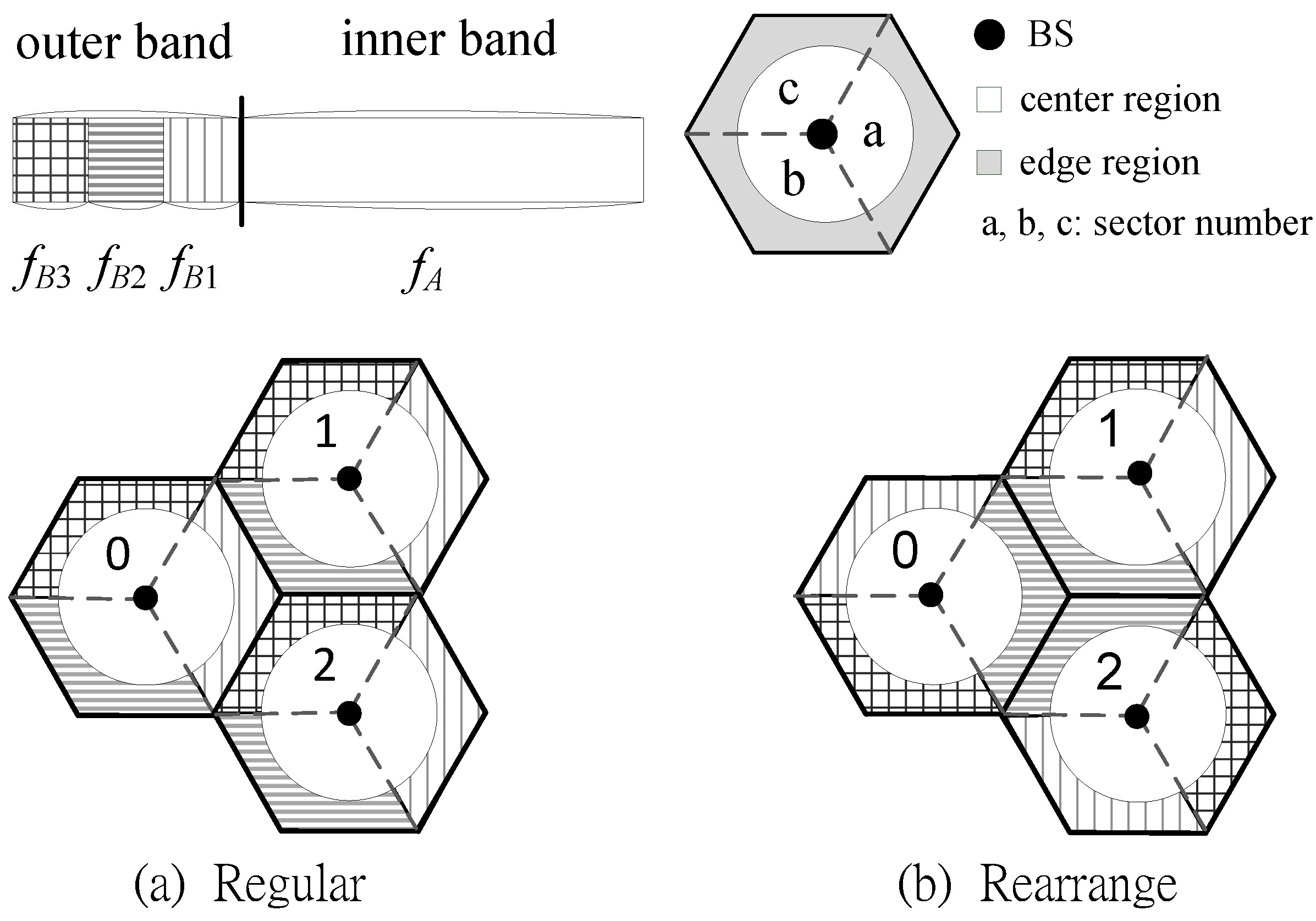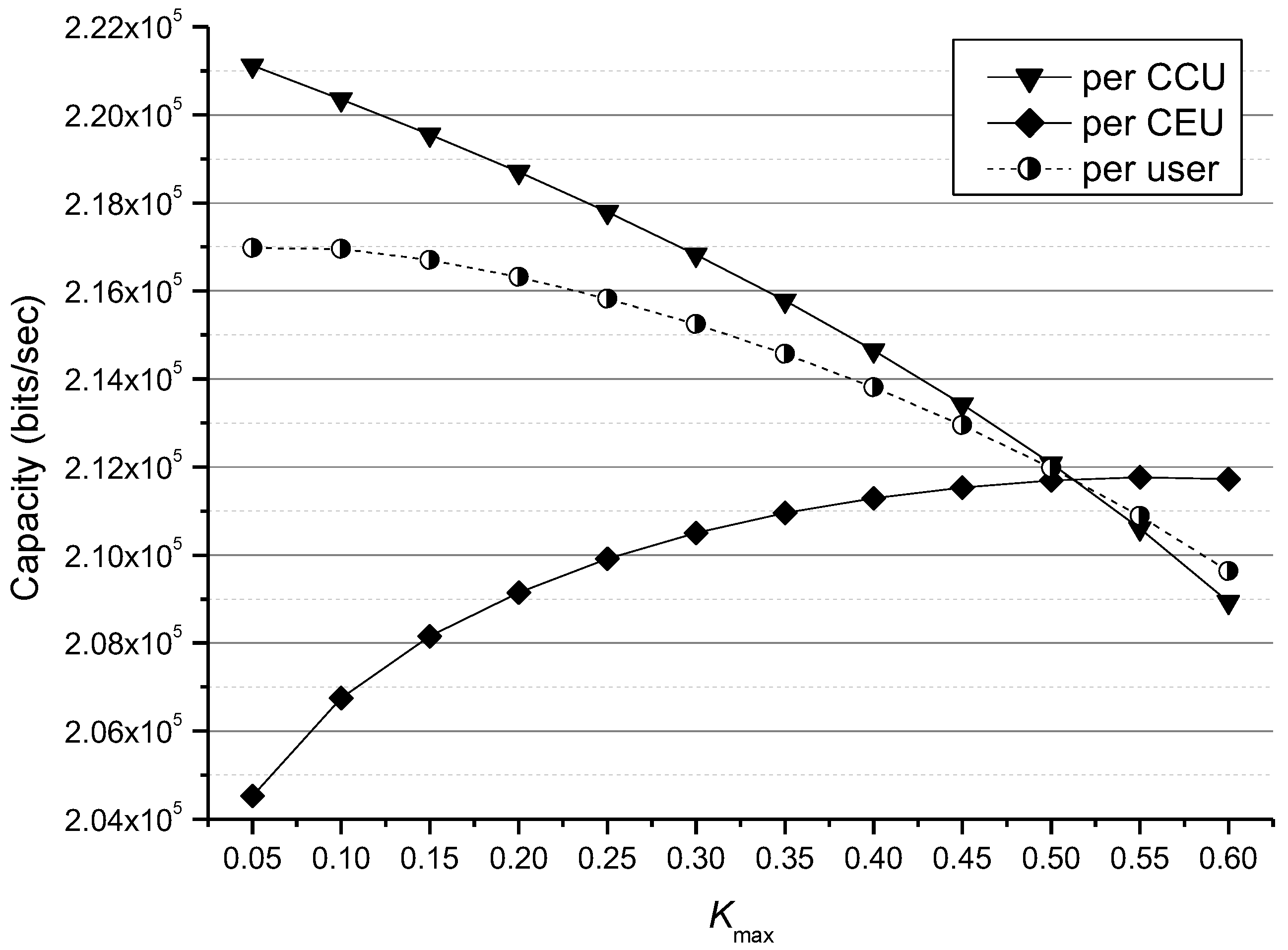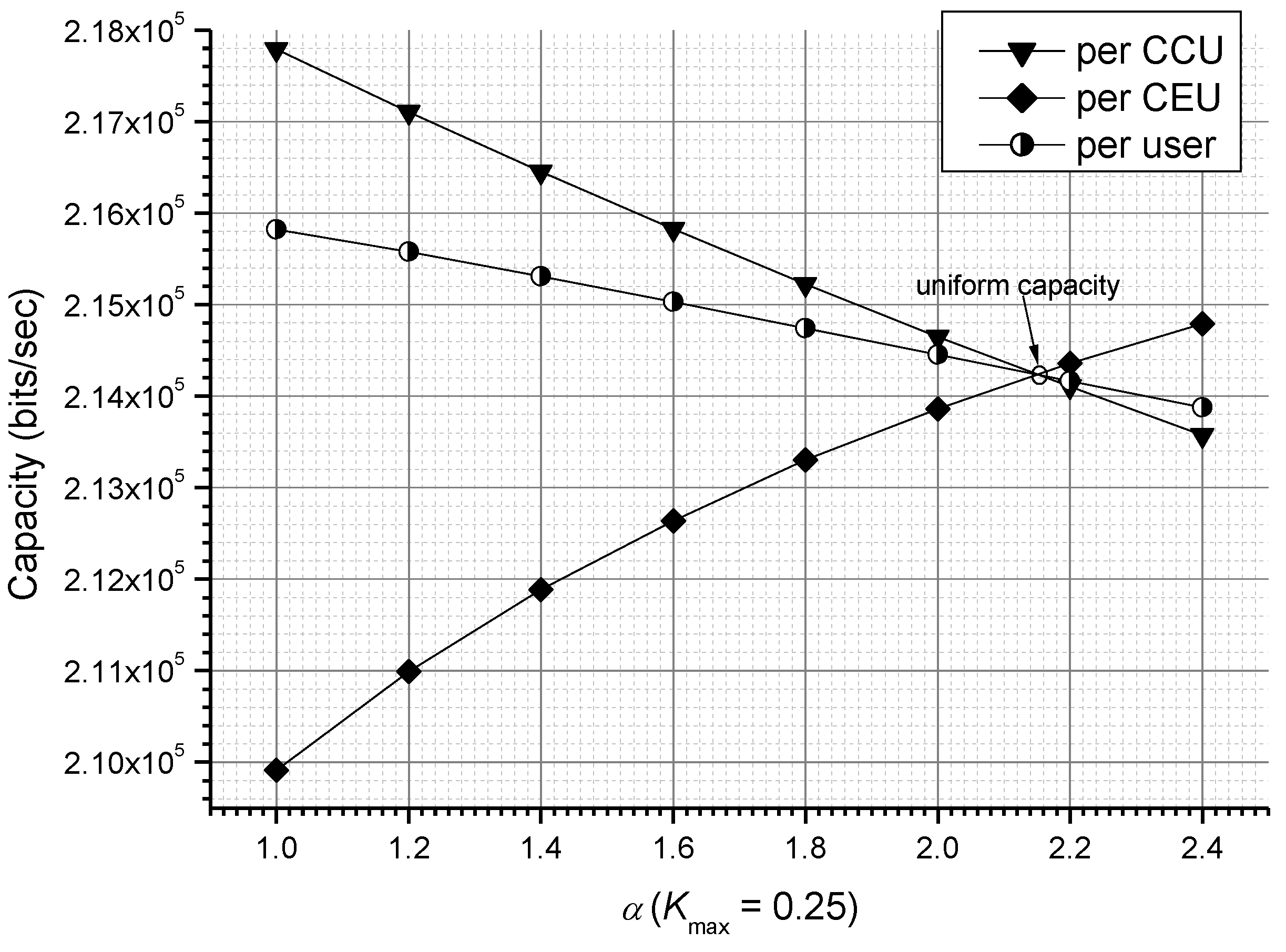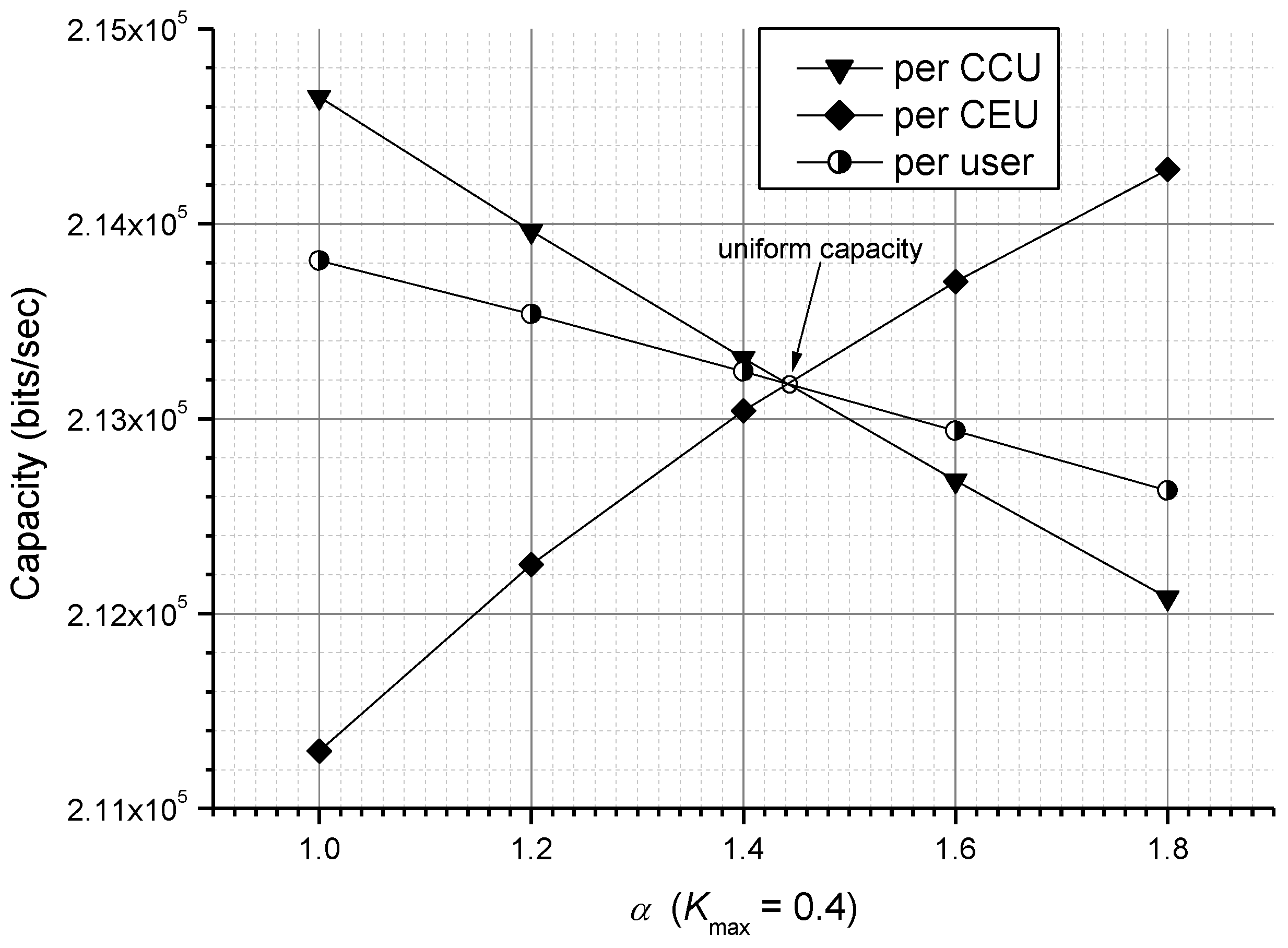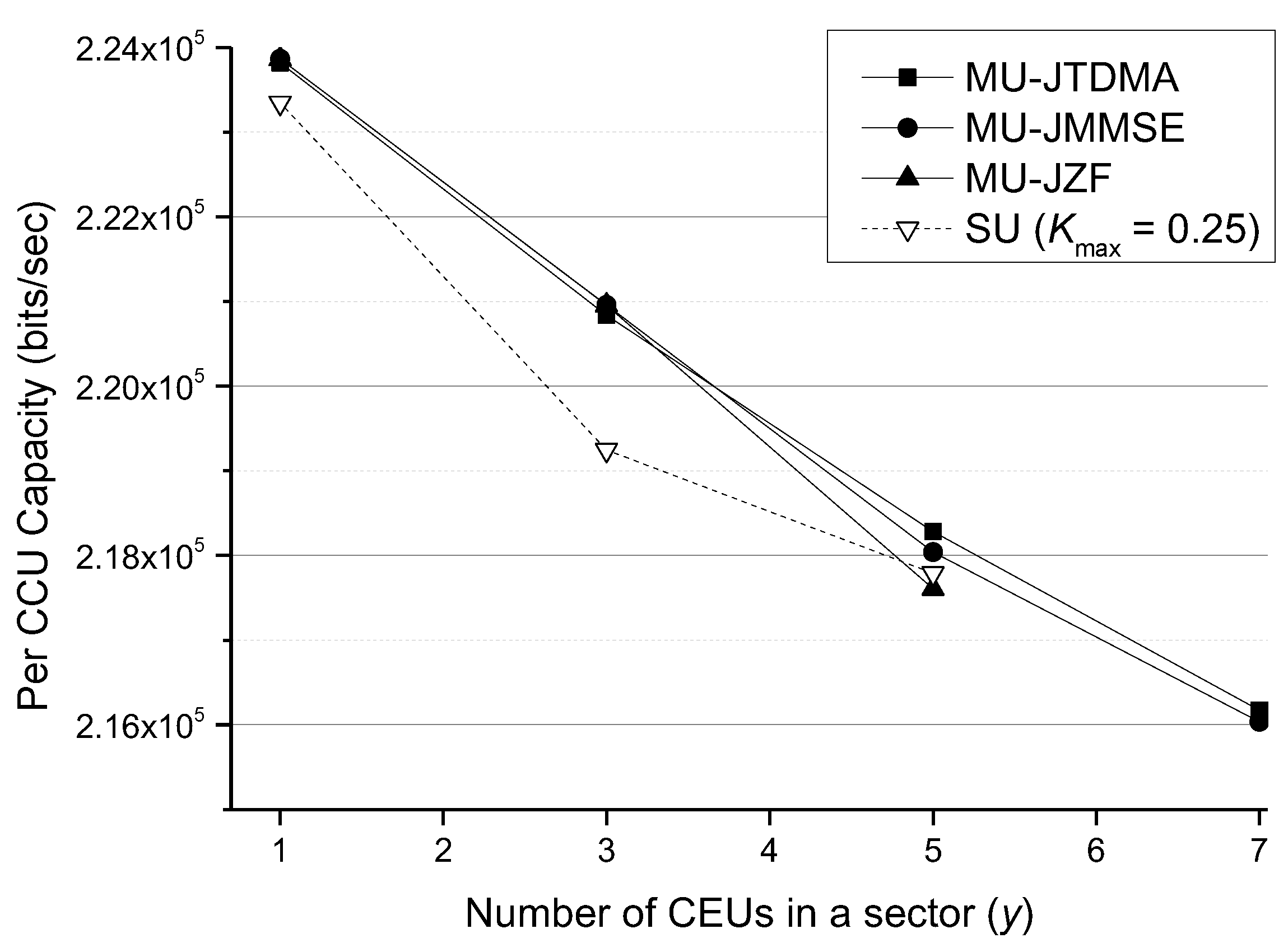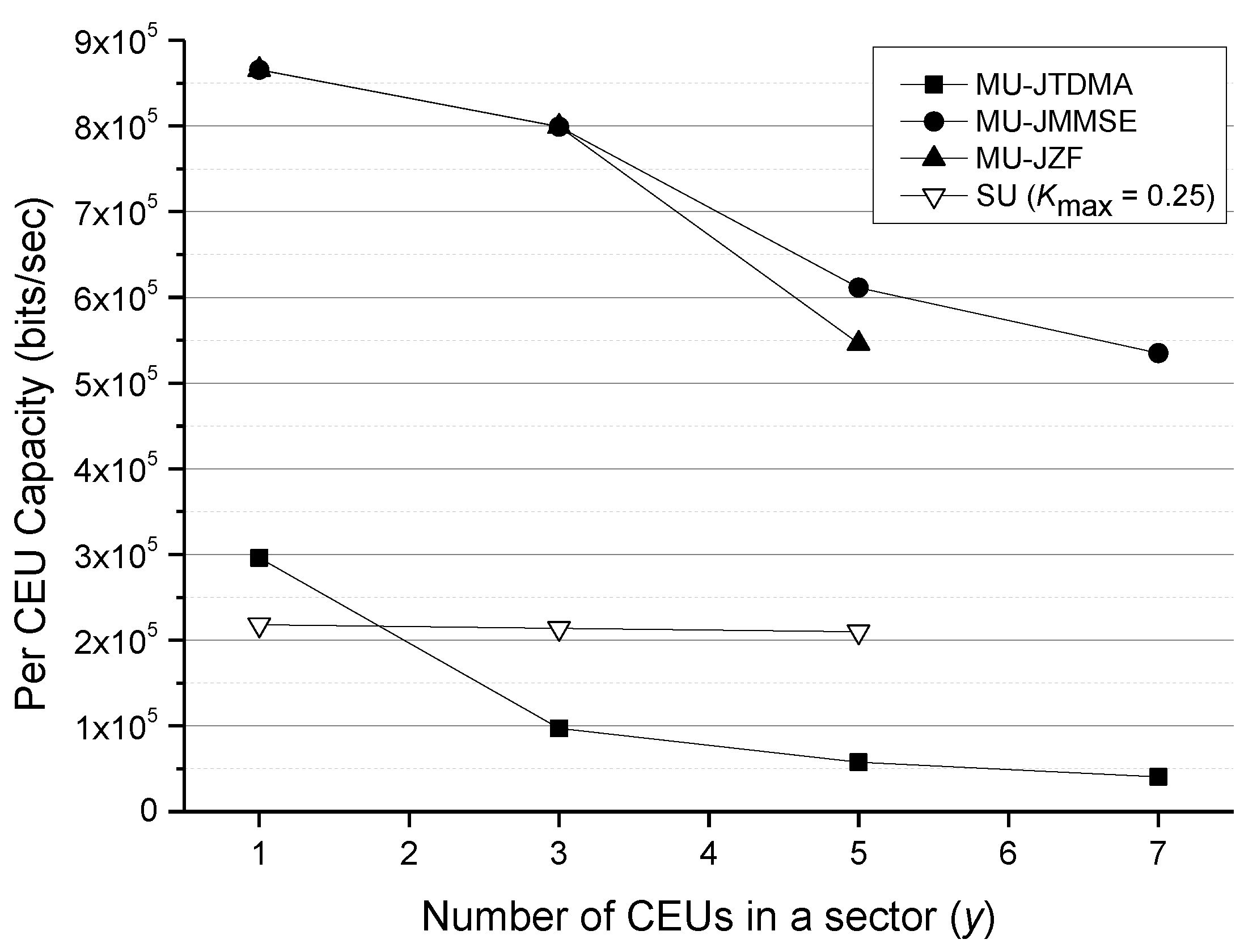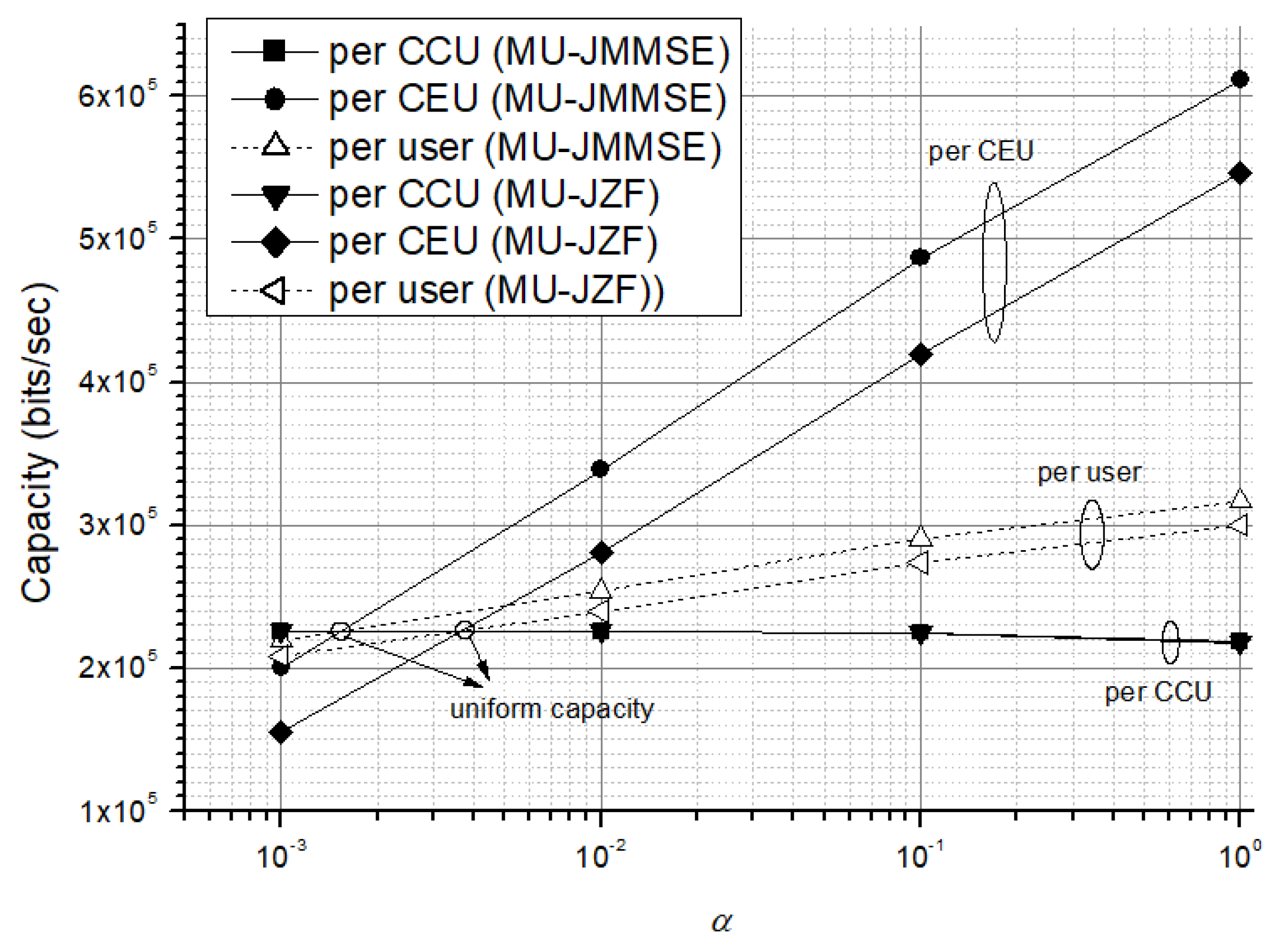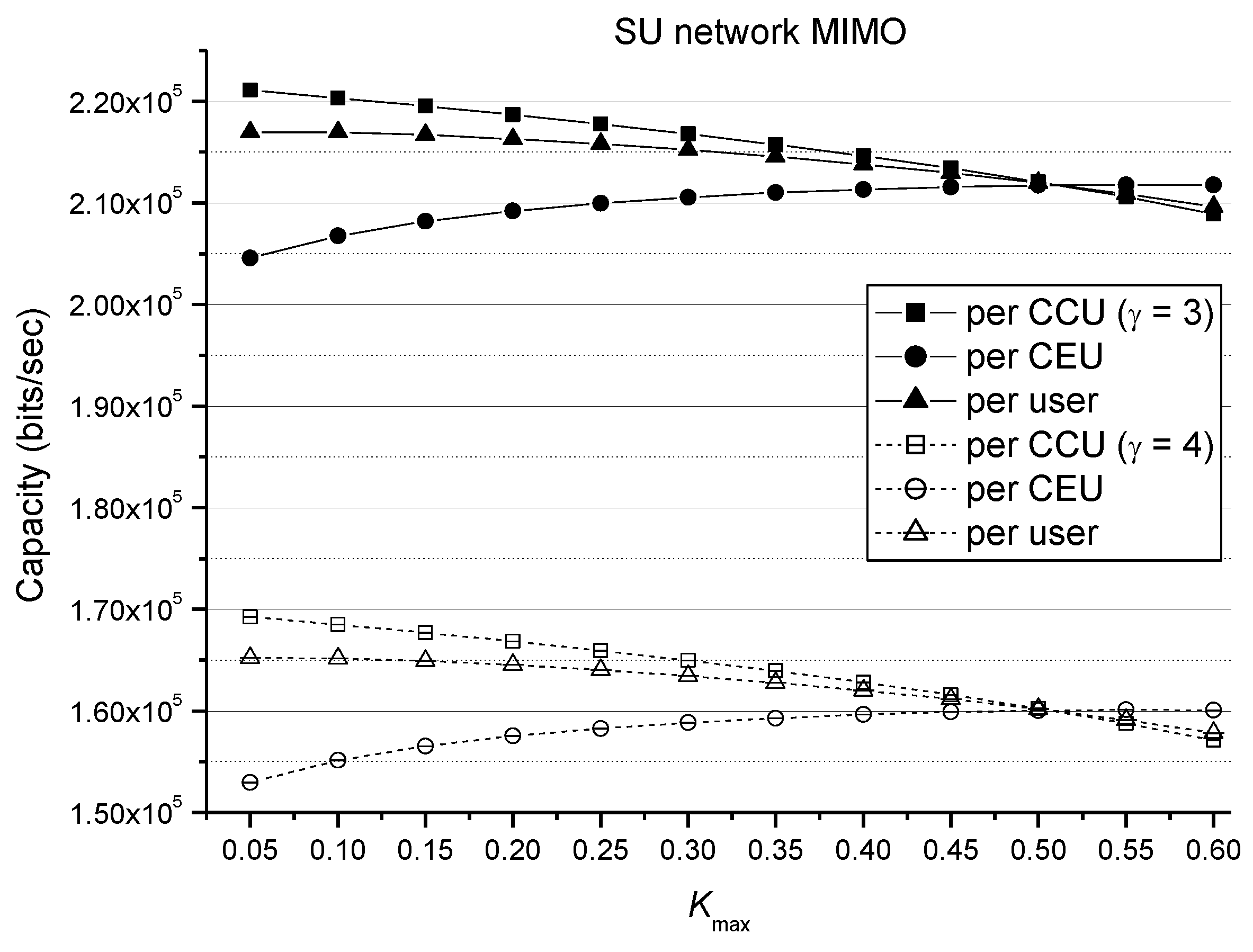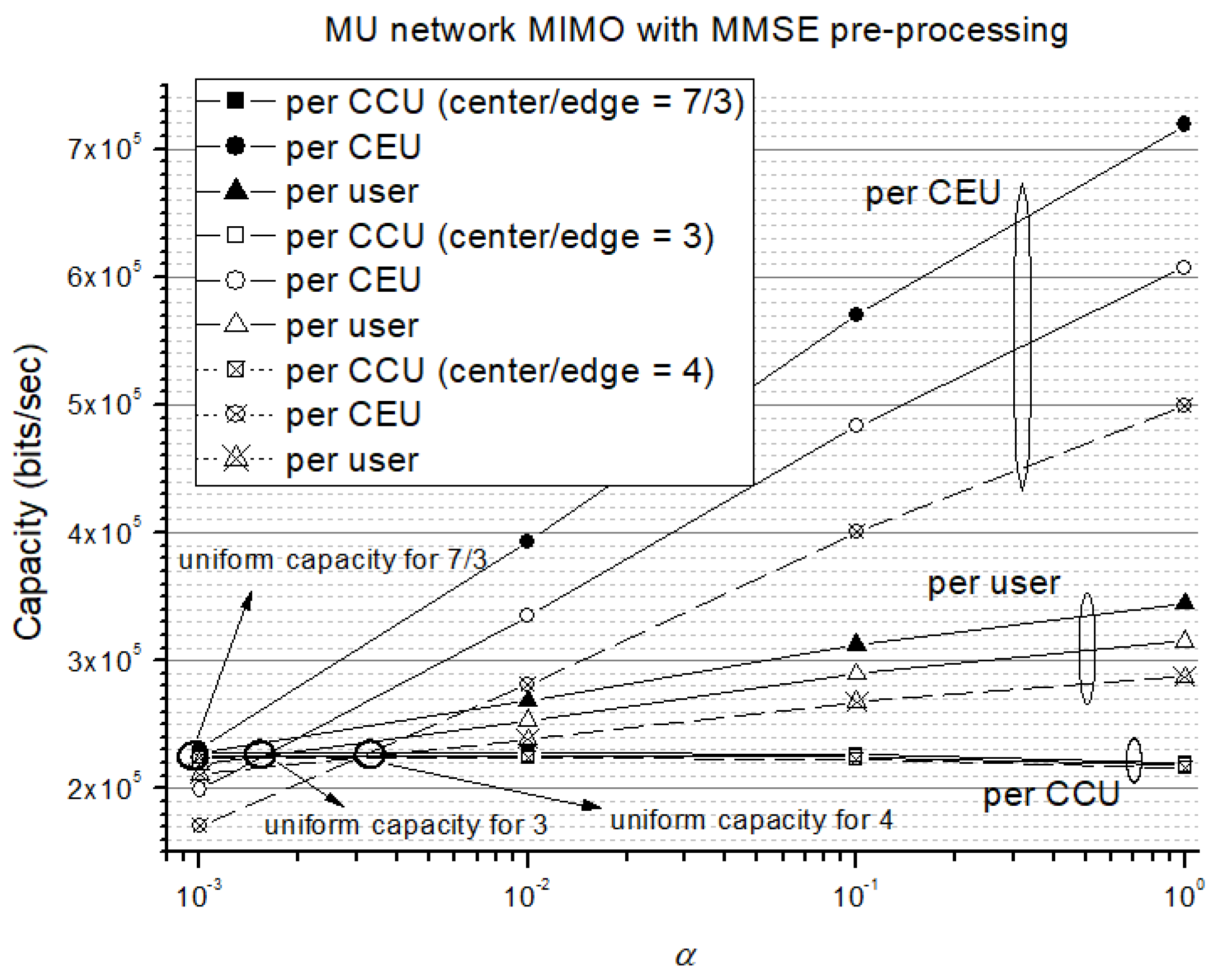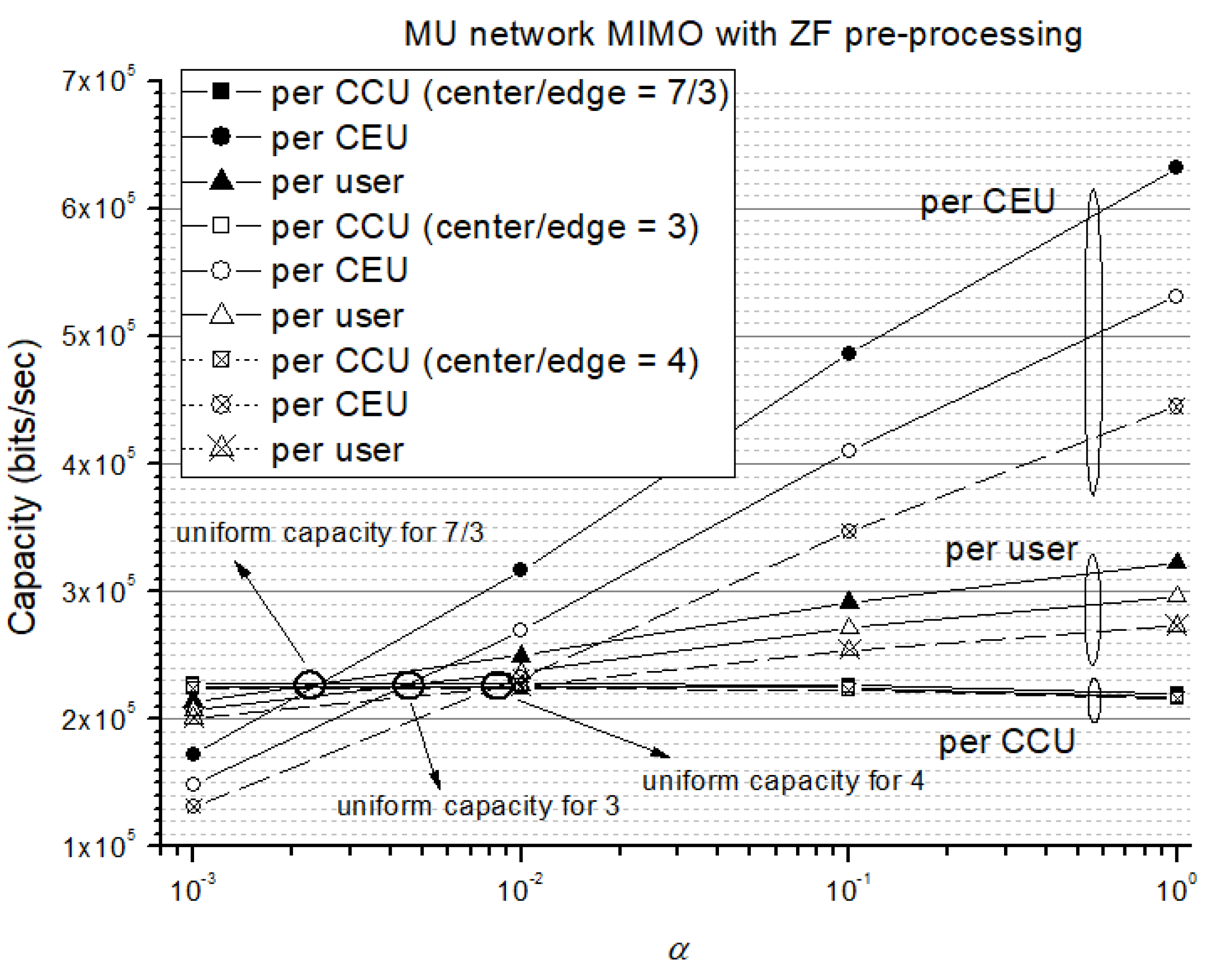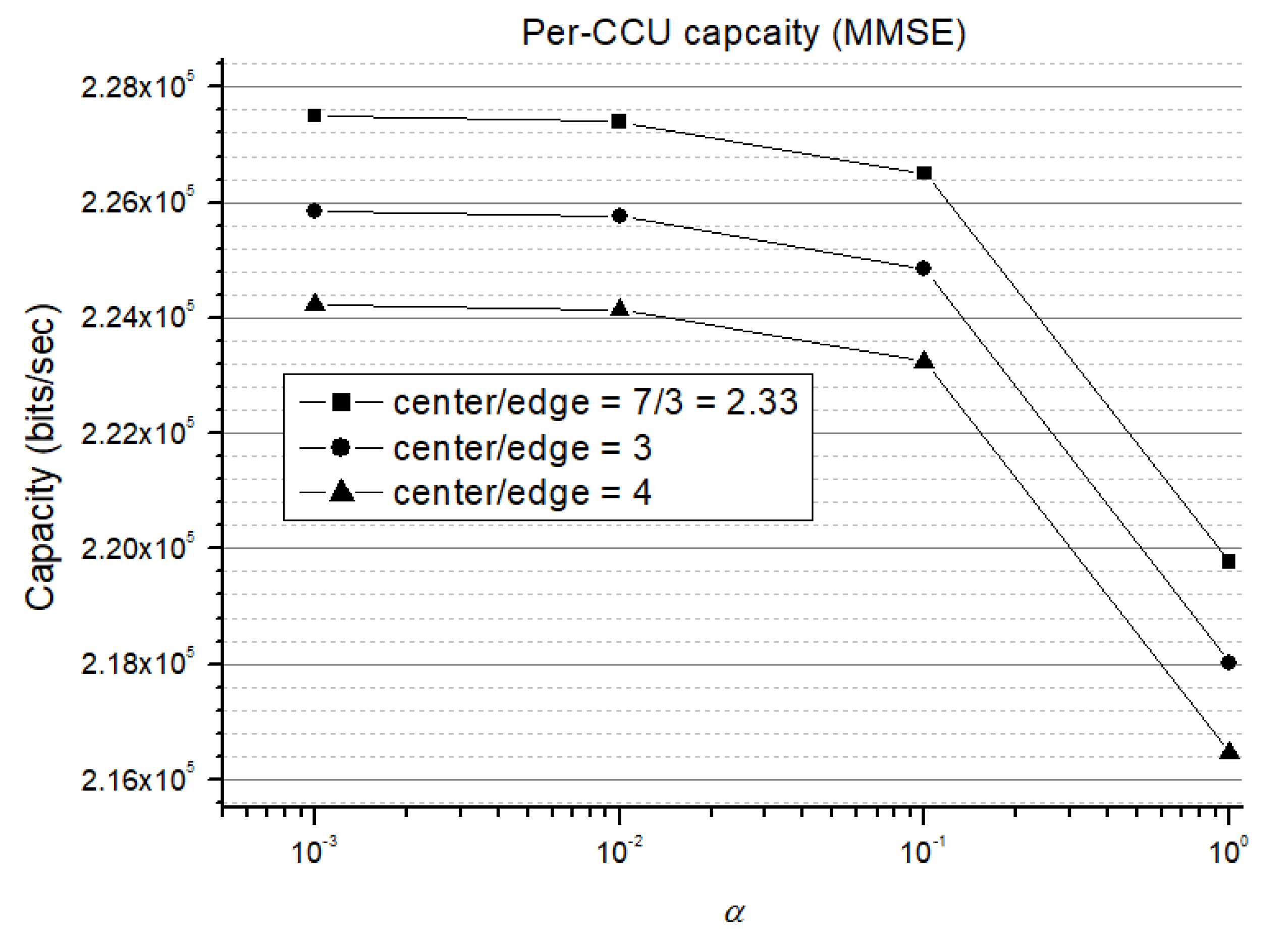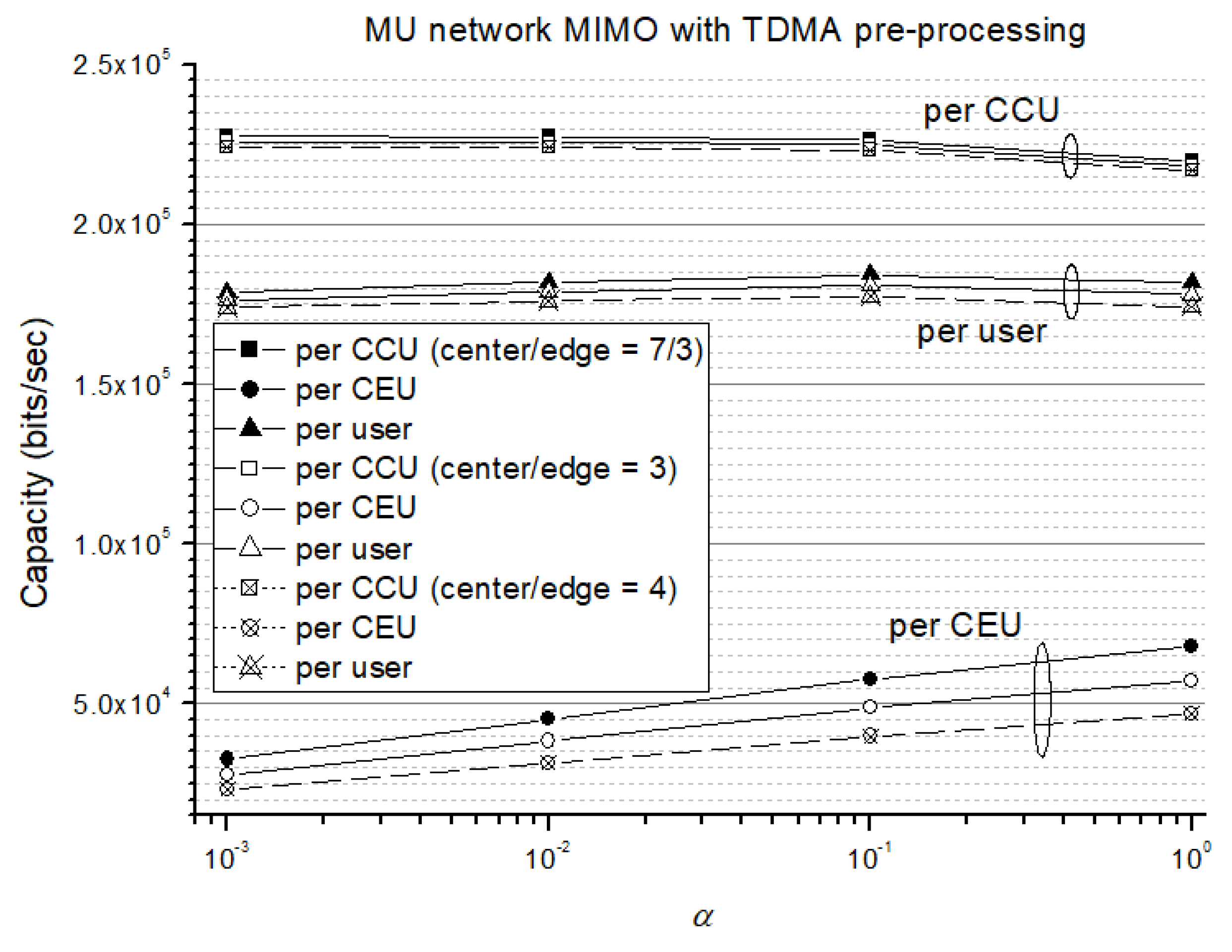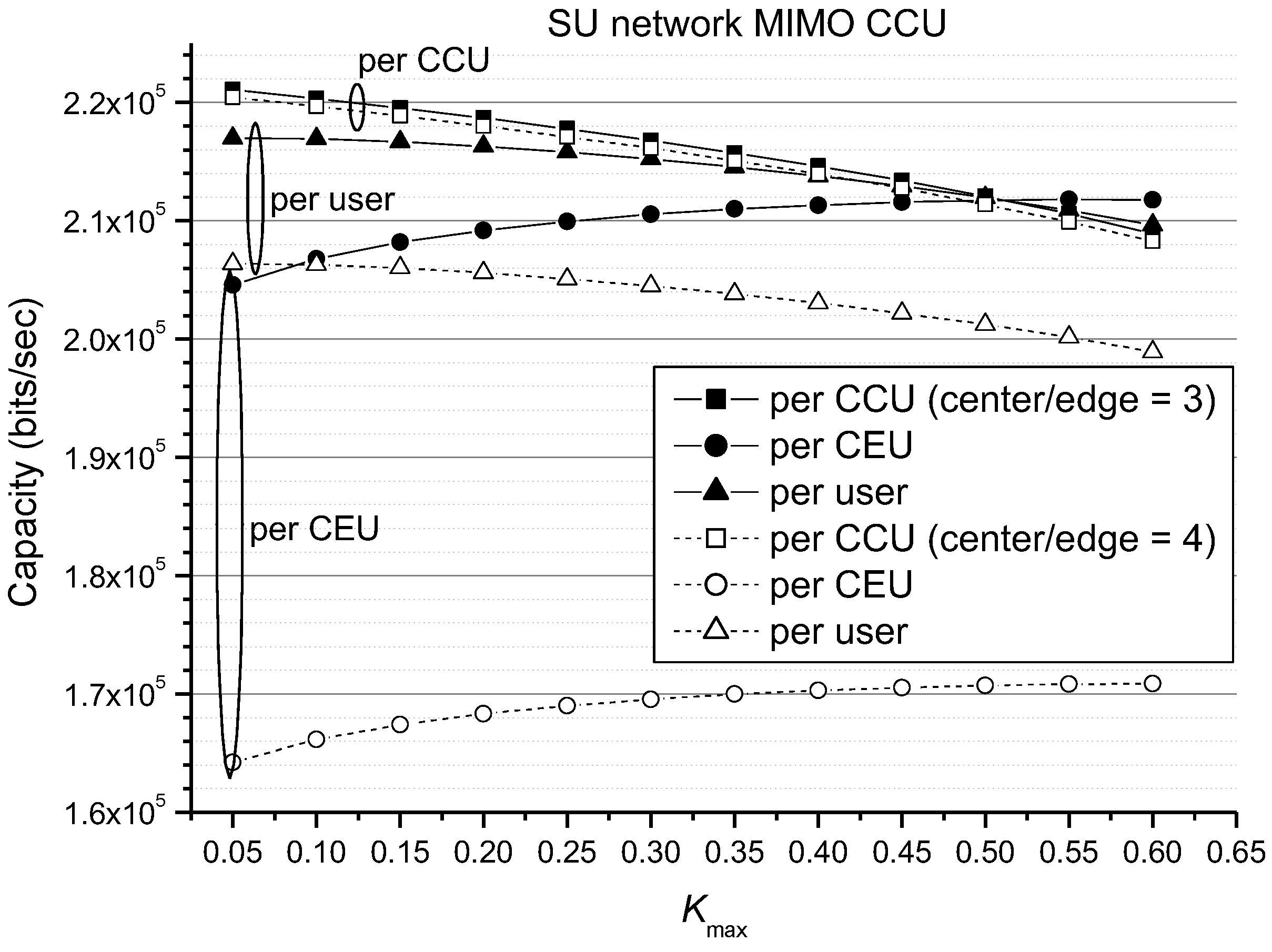1. Introduction
Cellular systems are targeting aggressive spectrum reuse via universal frequency reuse to achieve high spectral efficiency and simplify frequency planning [
1,
2,
3,
4,
5]. However, universal frequency reuse leads to unacceptable interference level at cell borders, i.e., the quality of service (QoS) remarkably depends on user location. To control this, cellular systems adopt several interference mitigation techniques to achieve uniform levels of QoS. Among these, network multiple-input multiple-output (MIMO) is used to mitigate the serious co-channel interference (CCI) and improve cell-edge performance. With network MIMO, multiple geographically separated base stations (BSs) collectively serve their cell-edge users (CEUs) using their antennas. These collaborative BSs can together serve either each individual CEU or a group of their CEUs during cooperative network MIMO transmission, which are called the single-user (SU) and multi-user (MU)-network MIMO, respectively. Network MIMO is referred to as coordinated multi-point (CoMP) in the Long-Term Evolution-Advanced (LTE-A) [
6].
Another key technique to combat the serious interference is inter-cell interference coordination (ICIC) [
7,
8]. Among a variety of ICIC strategies, the soft frequency reuse (SFR) and fractional frequency reuse (FFR) are widely adopted [
9,
10,
11]. Both schemes assign a frequency reuse factor of one for cell-center users (CCUs) and a larger frequency reuse factor for CEUs. In LTE-A cellular systems, FFR has been used to keep the inter-cell interference at cell edges as low as possible.
Combining both network MIMO and FFR-based ICIC can have the advantages of complexity reduction and throughput enhancement [
12]. In addition, the studies of network MIMO on top of the FFR-based cellular system have drawn increasing interest [
11,
12,
13,
14,
15]. It has been shown that using a 3-cell coordinated network MIMO with tri-sector frequency partition can outperform the 7-cell one with omni-directional antennas [
12]. The 3-cell coordinated network MIMO architectures have been particularly adopted by the IEEE802.16m WiMAX standard body, which has specified that the default number of neighboring cells in the collaborative network MIMO transmission is three. The FFR-related research was generally associated with the orthogonal frequency-division multiple access (OFDMA) systems [
11,
13].
In this paper, we consider two FFR-based frequency reuse methods for 3-cell network MIMO with tri-sector cells in OFDMA-based downlink cellular systems. They are regular and rearranged frequency partitions as shown in
Figure 1. In the conventional regular one, the adjacent sectors of neighboring cells are with different frequency bands [
13,
14,
16]. On the contrary, the rearranged frequency partition has the adjacent sectors of neighboring cells use the same frequency band. Thus, the rearranged frequency partition would yield serious CCI for network MIMO transmission. Regular and rearranged frequency partitions are associated with SU- and MU-network MIMO, respectively, to realize multi-cell cooperation. In this paper, we investigate the performance comparison between SU- and MU-network MIMO. In OFDMA systems, a collaborative BS can together serve its own users and the CEUs of other partner BSs under a transmitter power constraint. As a result, power management among three types of users (i.e., intra-cell CCUs, intra-cell CEUs, and inter-cell CEUs) becomes necessary. To the best of our knowledge, however, there has been no related literature dealing with this issue. Accordingly, we will develop methods of managing power to help raise the signal strength of inter-cell CEUs and in the meantime gratify the performance of intra-cell users. The rest of the paper is organized as follows. Tri-sector FFR-based frequency partitions (regular and rearrange) are introduced in
Section 2. In
Section 3, we present the signal model. Joint preprocessing techniques to eliminate serious CCI for MU-network MIMO are discussed in
Section 4. Methods of managing transmitter power are given in
Section 5. Simulation results are presented in
Section 6 and finally the conclusions are given in
Section 7.
2. Tri-Sector FFR-Based Frequency Partition
ICIC technique aims at minimizing CCI by efficiently coordinating channel allocation in adjacent cells. On top of network MIMO, this section introduces two FFR-based ICIC frequency reuse schemes as shown in
Figure 1. The spectrum is divided into the inner frequency band
and outer frequency band
, where
is further partitioned into three equal sub-bands (
,
and
) [
12,
15]. The inner and outer frequency bands are for CCUs’ and CEUs’ exclusive use, respectively. The differentiation between CEU and CCU can be made based on the received signal-to-interference-plus-noise ratio (SINR) at the user equipment [
17]. All the CCUs within a cell share the sub-channels in inner frequency band
. However, we serve a CEU either on a specific sub-channel of a sub-band
or on an entire sub-band
for SU- and MU-network MIMO, respectively. Specifically, the inner band
adopts universal reuse factor with omni-directional antenna for CCUs; the outer bands
uses frequency reuse factor of three for CEUs in each sector.
As mentioned in the previous section, we consider two frequency partitions (regular and rearranged) in
Figure 1 [
12]. Traditionally, the regular frequency planning in
Figure 1a is the FFR-based frequency partition for a tri-sector cellular system, where the sectors of different cells with the same outer sub-band have the same main-beam direction. Accordingly, with regular frequency planning, the contiguous cell-edge areas of neighboring cells are assigned to different orthogonal outer sub-bands
to avoid CCI as shown in
Figure 1a. On the contrary, with rearranged frequency planning, the sectors of different cells with the same outer sub-band have different main-beam direction as shown in
Figure 1b, where contiguous cell-edge areas of neighboring cells are with the same outer sub-bands.
In both SU- and MU-network MIMO, each CEU is served by a group of collaborative BSs. These BSs form a cooperative cell set (CCS) associated with that CEU. For convenience, let a BS sector
denote the sector
of cell
. For example, consider a certain CEU
located in the cell-edge area of sector
for regular frequency planning in
Figure 1a. For this CEU
, we have the corresponding CCS
, which use a particular sub-channel selected from outer sub-band
to collectively serve the CEU
. This is SU-network MIMO transmission. As in frequency-division multiple access (FDMA), SU-network MIMO allocates each CEU a unique sub-channel from an outer sub-band and thus the cooperative BSs in a CCS result in no multi-user interference. As for the rearranged one in
Figure 1b, the collaborative BSs in CCS
turn to together serve a group of their CEUs using the sub-band
(i.e., MU-network MIMO), i.e., all CEUs in this group share the entire sub-band
. As a result, the serious multi-user interference is inevitable. To control this, joint preprocessing among cooperative BSs is necessary in MU-network MIMO with rearranged frequency planning.
5. Transmission Power Management
As mentioned earlier, each of BSs in a CCS together serves its own users and the CEUs of other collaborative BSs under a power constraint. Therefore, it is necessary to develop a method of distributing transmitter power among intra-cell CCUs, intra-cell CEUs, and inter-cell CEUs. To the best of our knowledge, however, there has been no literature dealing with this issue. The purpose of power management is to achieve a uniform capacity regardless of user position. Because of the cooperation with the neighboring BSs, the design of power management may involve the information exchange among the cooperative-based stations. Due to the time-variant characteristics of channel, this continuing need for information exchange will consume a lot of radio resources. In the absence of information exchange, our method of power management for MU-network MIMO cellular systems only needs the number of different types of users to realize an independent power adjustment among BSs.
Let , and denote the sub-channel power allocated for an intra-cell CCU, intra-cell CEU, and inter-cell CEU, respectively. Let denote a sub-channel baseline power and represent the maximum transmission power constraint in a sector antenna. In our method, a CCU and a CEU are respectively allotted the initial power and , where the power coefficient , i.e., we initially set and .
The power management is conducted in a per-sector basis. Let , and denote the number of intra-cell CCUs, intra-cell CEUs, and the inter-cell CEUs served by a particular sector antenna, respectively. Thus, the total power requirement is , where the power required to serve other cells’ CEUs is . In the subsequent sub-sections, we present transmission power management for SU- and MU-network MIMO, respectively.
5.1. Power Management for SU-Network MIMO
For a specific CCS, define to be the power ratio consumed by inter-cells’ CEUs, i.e., we partition the total transmitter power into two parts: power for intra-cell users and power for inter-cells’ CEUs (). Accordingly, we can use the power ratio to limit the maximum power dispensed to inter-cells CEUs. Therefore, the power consumption is limited within . In a per-sector antenna basis, the procedure of power management is presented as follows.
- (a)
Initialize the power allocation to each of CCUs and CEUs by and , respectively.
- (b)
Calculate the amount of power consumed by the other cells’ CEUs (i.e., ). If , then reduce the power allocation for each inter-cell CEU by a factor of such that the amount of power consumption by the other cells’ CEUs equals the power constraint , where ; elsewise .
- (c)
Next calculate the total transmission power for intra-cell users (i.e., ). If , then reduce the initial power by a factor of such that equals the upper bound power , where ; elsewise .
- (d)
Finally, we achieve , and .
In summary, the method consists of a CEU power coefficient and two power reduction factors ( and ). The coefficient is used to determine the power proportion between a CCU and a CEU. The power allotted to other cells’ CEUs can be restricted by power reduction factor together with the power ratio . As for the power reduction factor , it prohibits a power requirement from exceeding the corresponding power constraint . To best use the transmitter power, we initially assume that the baseline power is equal to . Thus, the two power portions and can be fully used.
5.2. Power Management for MU-Network MIMO
Unlike SU-network MIMO, each of CEUs in MU-network MIMO shares the entire sub-band
instead, as shown in
Figure 1b. This yields serious multi-user interference and thus joint preprocessing among cooperative BSs becomes necessary, as discussed in
Section 4. Since the preprocessing matrices are jointly designed for all the CEUs, there is no distinction between intra-cell and inter-cell CEUs
. Thus, there is no need for
for power management in MU-network MIMO. Initially the power
for each intra-cell CCU is
. The total power requirement for cooperative BS
to serve the
CEUs is
as shown in (18). We define the average preprocessing power for a CEU as
. As in SU-network MIMO, the CEU power is
. However, the CEU power depends on the average preprocessing power
, which is variable because of the time-variant channel. Thus, we further let the CEU power be
, where
is determined such that
. Therefore, we achieve
.
For each sector antenna, the procedure of power management is as follows.
- (a)
Initialize the power allocation to each of CCUs by .
- (b)
Calculate the average preprocessing power according to (18). Then set the CEU power , where .
- (c)
Next, calculate the total power requirement . If , then reduce the baseline power by a factor of such that the value of equals the power constraint , where ; elsewise .
- (d)
Finally, we achieve and .
In summary, the method consists of a CEU power coefficient and a power reduction factor . We adaptively adjust the value of such that . The power reduction factor is used to make sure that the total power requirement does not exceed the power constraint .
6. Simulation Results
This section presents performance comparison between SU and MU-network MIMO with the power management methods. Unless otherwise stated, the cell radius
and cell-center radius
are 1000 m and 787.55 m, respectively. Accordingly, within a sector, the ratio of cell-center area to cell-edge area is 3 to 1. Assume users are uniformly distributed in each cell. Thus, we set the ratio of sub-channel number between inner band
and outer band
to be 3 to 1 as well. To this end, we assume the total number of OFDMA sub-channels is 60 such that the numbers of sub-channels in
and
are integers 45 and 15, respectively. Therefore, each outer sub-band
consists of 5 OFDMA sub-channels. As a result, for SU-network MIMO, there are at most five active CEUs in each sector (hard CEU capacity). As for MU-network MIMO, joint preprocessing makes it possible that more than five CEUs in each sector can be served at the same time (soft CEU capacity). Assume there are 12 subcarriers in a sub-channel and the sub-channel bandwidth
is 138.8 KHz. The maximum power constraint
is 46.523 dBm [
2]. The propagation constant
and path loss exponent
are
and 3, respectively [
20]. The standard deviation of log-normal shadowing is 12 dB. Unless otherwise stated, there are 15 CCUs
and 5 CEUs
uniformly distributed in each sector, each sector is equipped with five transmission antennas
and the power coefficient is one
. As for users, each of them is equipped with a single receiver antenna
. In terms of different values of
,
Figure 2 shows the capacity comparison for SU-network MIMO and
Figure 3 presents its corresponding curves of power reduction factors. In
Figure 2, we find that smaller
yields better per-user (average) capacity than larger
. However, smaller
results in bigger capacity gap between CCU and CEU than larger
. Thus, through continuing enlarging the value of
, the capacity gap can be reduced, but it is at the cost of decreasing the average capacity. For example, in
Figure 2, an equal CCU and CEU capacity (zero capacity gap) occurs at about
, i.e., a uniform capacity is achieved regardless of user position; however, it obviously reduces the average capacity.
Figure 3 shows that while the value of
is increasing, the power factor
is increasing as well. This is because a larger value the
means that more transmitter power is allocated to the inter-cell CEUs. Accordingly, the power factor
associated with intra-cell users is decreasing while the value of
is increasing.
As a function of power coefficient
,
Figure 4 shows the capacity comparison for SU-network MIMO with a small
(say
). Please note that the CEU power is given by
. Thus, we can raise the CEU power by increasing the value of
. It is found that increasing the value of
can actually diminish the capacity gap between CCU and CEU, and a uniform capacity is achieved at
. However, the average (per-user) capacity is also slowly decreasing at the same time, while the capacity gap is decreasing. In
Figure 5, we present the capacity comparison as a function of
for a large
(say
). It is shown that the uniform capacity occurs at a smaller
,
, as compared with
associated with the smaller
in
Figure 4. By making a comparison between
Figure 4 and
Figure 5, it is found that the per-user (average) capacity with smaller
is always better than that with larger
, although it yields larger capacity gap than that of larger
. Nevertheless, while achieving uniform capacity (zero capacity gap), the smaller
still yields better average capacity (about
bits/sec) than that with the larger
(about
bits/sec). Therefore, with
, SU-network MIMO offers
more bits per second than that with
. In conclusion, with uniform capacity, smaller
can generally provide the SU-network MIMO with larger average capacity.
Uniform capacity makes sure that users have uniform data rate regardless of their position. According to the previous results, we found that uniform data rate comes at the price of reducing the average capacity. Studies on wireless usage show that more than 50% of all voice calls and more than 70% of data traffic originate from indoors (i.e., immobile conditions) [
24]. As a result, the uniform capacity is only important for the small part of truly mobile users. For example, as a mobile user with SU-network MIMO moves from cell center to cell border, the cell-edge capacity will drop a small percentage as compared with cell-center capacity, and thus the user may be deficient in capacity. Thus, uniform data rate is essential for this scenario.
Now we turn our attention to the MU-network MIMO and in the meantime, make comparison with SU-network MIMO. In terms of the number of per-sector CEUs (
),
Figure 6 presents the per-CCU capacity comparison for three MU-network MIMO schemes and the SU-network MIMO. Recall that three cooperative BSs in a CCS collectively serve a group of
CEUs using a whole out sub-band. Thus, we have
for MU-network MIMO. In MU-network MIMO, both MU-JMMSE, and MU-JTDMA have soft CEU capacity, but MU-JZF does not, because it is subject to the usage constraint
as shown in
Section 4.2. In general, it is found that MU-network MIMO is better than SU-network MIMO in CCU capacity, except for MU-JZF at
, whose CCU capacity is slightly less than SU-network MIMO.
Figure 7 gives the per-CEU capacity comparison. Except for the orthogonal scheme (MU-JTDMA), it is found that the superposition-coding schemes (MU-JMMSE and MU-JZF) have obvious CEU capacity improvement over the SU-network MIMO [
25]. In addition, since there are just 5 sub-channels in an outer frequency sub-band, the SU-network MIMO only can serve up to 5 CEUs per sector. By contrast, the MU-network MIMO has a soft capacity for CEUs, except for MU-JZF because it is subject to the usage constraint
. For example, as increasing two additional CEUs from 5 CEUs to 7 CEUs in each sector, we calculate that the MU-JMMSE only drop about 0.9% and 15.2% for per-CCU and per-CEU capacity, as shown in
Figure 6 and
Figure 7, respectively.
Figure 8 shows the capacity comparison for both superposition-coding schemes (MU-JMMSE and MU-JZF) as a function of
. It is found that the per-CEU capacity is much better than the per-CCU capacity (at
) because of joint preprocessing. By contrast, for SU-network MIMO with
, its per-CEU capacity is still distinctly worse than the per-CCU capacity, as shown previously in
Figure 4 and
Figure 5. This means that the joint preprocessing (superposition coding) offers great preprocessing gain that benefits per-CEU and per-user (average) capacities. Recall that
, where
is the CCU power. Due to the excellent preprocessing gain, the MU-network MIMO can use extremely small value of
(i.e., very small CEU power) to achieve uniform data rate, say
and
for MU-JMMSE and MU-JZF, respectively. This is opposite to SU-network MIMO. Moreover, it is found that MU-JMMSE is better than MU-JZF. This is because MU-JZF completely eliminates the CCI at the cost of demanding higher transmitter power. However, MU-JMMSE makes an acceptable compromise between interference suppression and transmitter power efficiency.
The numerical results above are obtained under the path loss exponent
of 3. Changing the value of
to a typical value of 4 does not influence the previous numerical results. For example,
Figure 9 shows the same observations in SU-network MIMO for both path loss exponents (
), i.e., smaller
yields better per-user (average) capacity than larger
. However, smaller
produces bigger capacity gap between CCU and CEU than larger
. Likewise, in MU-network MIMO, the observed phenomena are also the same for different values of path loss exponent.
Figure 10 and
Figure 11 show the capacity comparison between different values of path loss exponent
with MMSE and ZF joint preprocessing, respectively. It is found that the per-CEU capacity is much better than the per-CCU capacity at
because of taking advantage of joint preprocessing. It is worth mentioning that, however, although the path loss increases with a larger path loss exponent
, we need to allocate more power to CEUs by increasing the value of
to achieve a uniform capacity as shown in
Figure 10 and
Figure 11.
Next, we show how the different ratios between cell-center and cell-edge area influence the result.
Figure 12 and
Figure 13 are numerical results for the superposition-coding MU-MMSE and MU-ZF joint preprocessing schemes, respectively. Because the variation of CCU capacity is much less obvious than that of CEU capacity, we give a separate illustration for CEU capacity in
Figure 14, where only the MMSE CCU capacity is shown because both MMSE and ZF are similar. The result of the orthogonal MU-TDMA joint preprocessing scheme is given in
Figure 15. Finally,
Figure 16 shows the result for the SU-network MIMO. With superposition-coding MU-MMSE and MU-ZF schemes,
Figure 12 and
Figure 13 indicate that reducing the ratio (i.e., increasing the edge area, but decreasing the center area) significantly benefits the CEU capacity. For example, this can be found from the decrease in the value of α to achieve uniform data rate as shown in
Table 1. As for the CCU, while cell-center area is reduced, the interference from neighboring cells is decreased and thus there is also a slight increase in CCU capacity as shown in
Figure 14. In
Figure 15, the result of the orthogonal MU-TDMA joint preprocessing scheme is similar to the superposition-coding schemes, i.e., increasing the cell-edge area benefits the capacity for either CEU or CCU capacity. The same observations are also true for SU-network MIMO in
Figure 16, where we just show two different area ratios for clarity of illustration. It also shows that decreasing the center area significantly benefits the CEU capacity and improves the CCU capacity slightly. Overall, the system capacity increases due to enlarging the cell-edge area, which directly increases the proportion of downlink multi-cell cooperation (network MIMO) transmission. With network MIMO, multiple geographically separated base stations cooperatively serve their CEUs using their antennas, acting together as a network of distributed antenna array. In fact, this network architecture not only can effectively mitigate the serious co-channel interference but also provide diversity transmission. However, it is worth mentioning that the disadvantages of cooperative transmission require additional overhead for information exchange among cooperative BSs.
